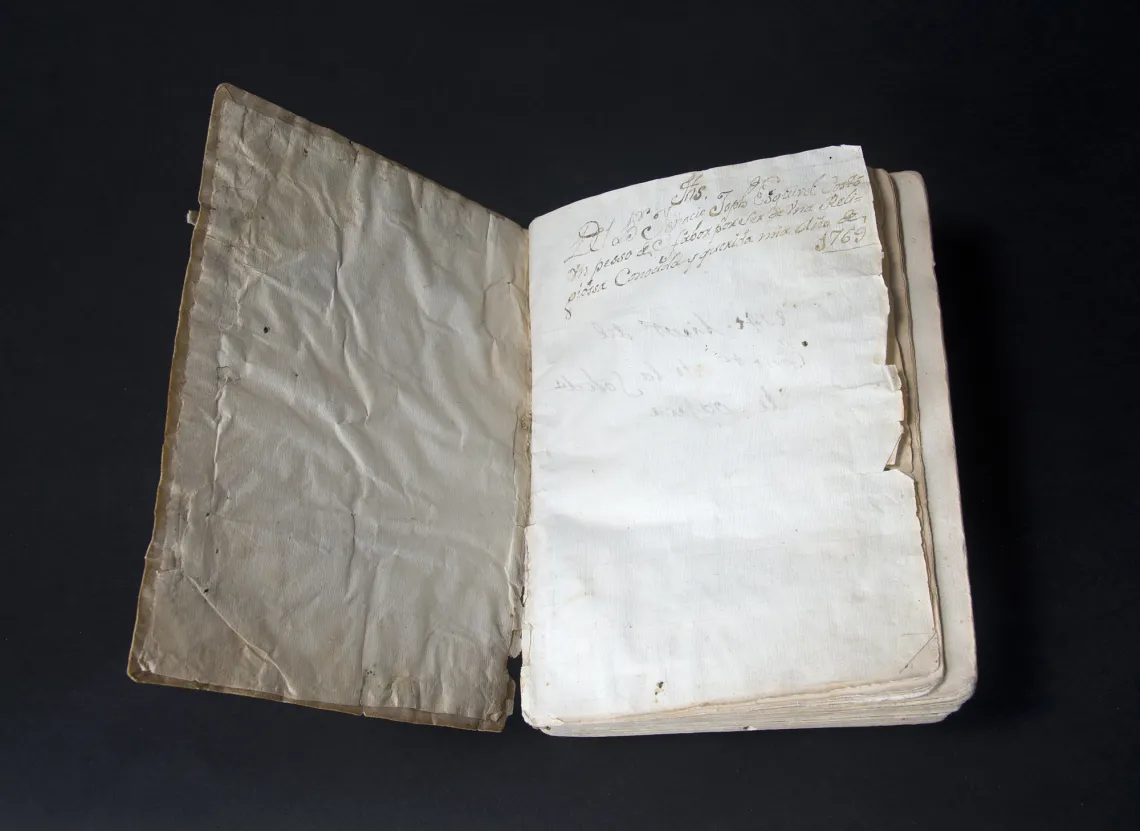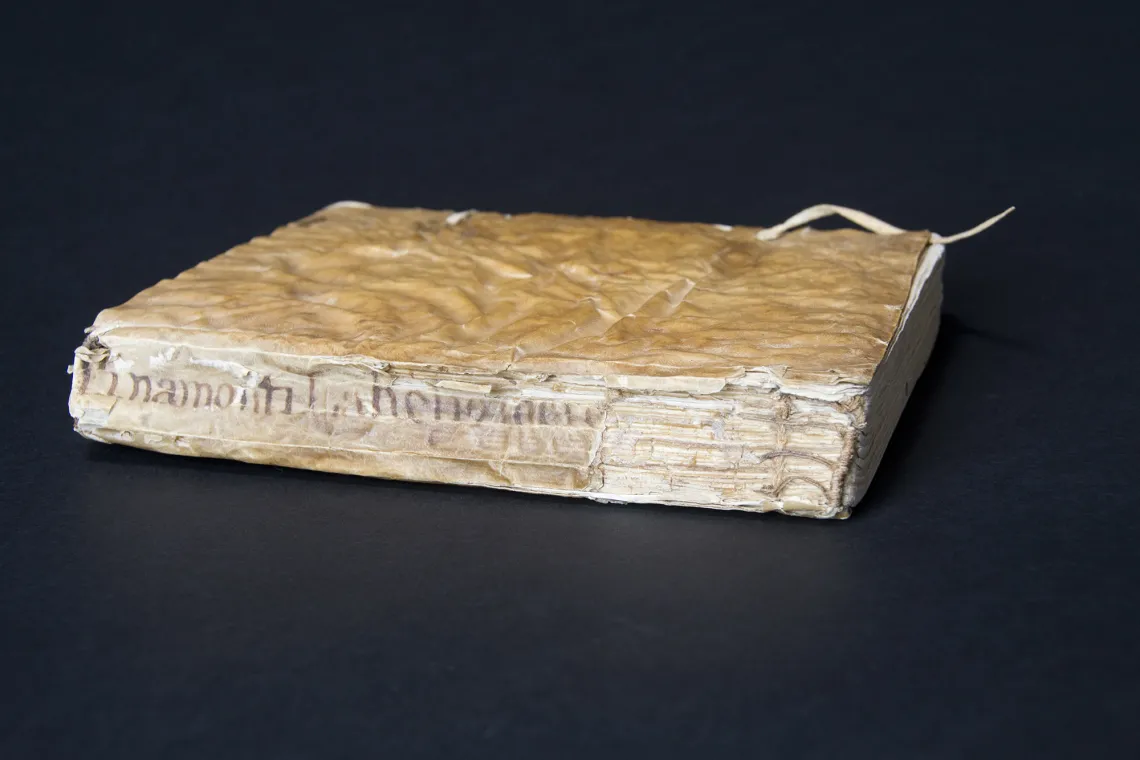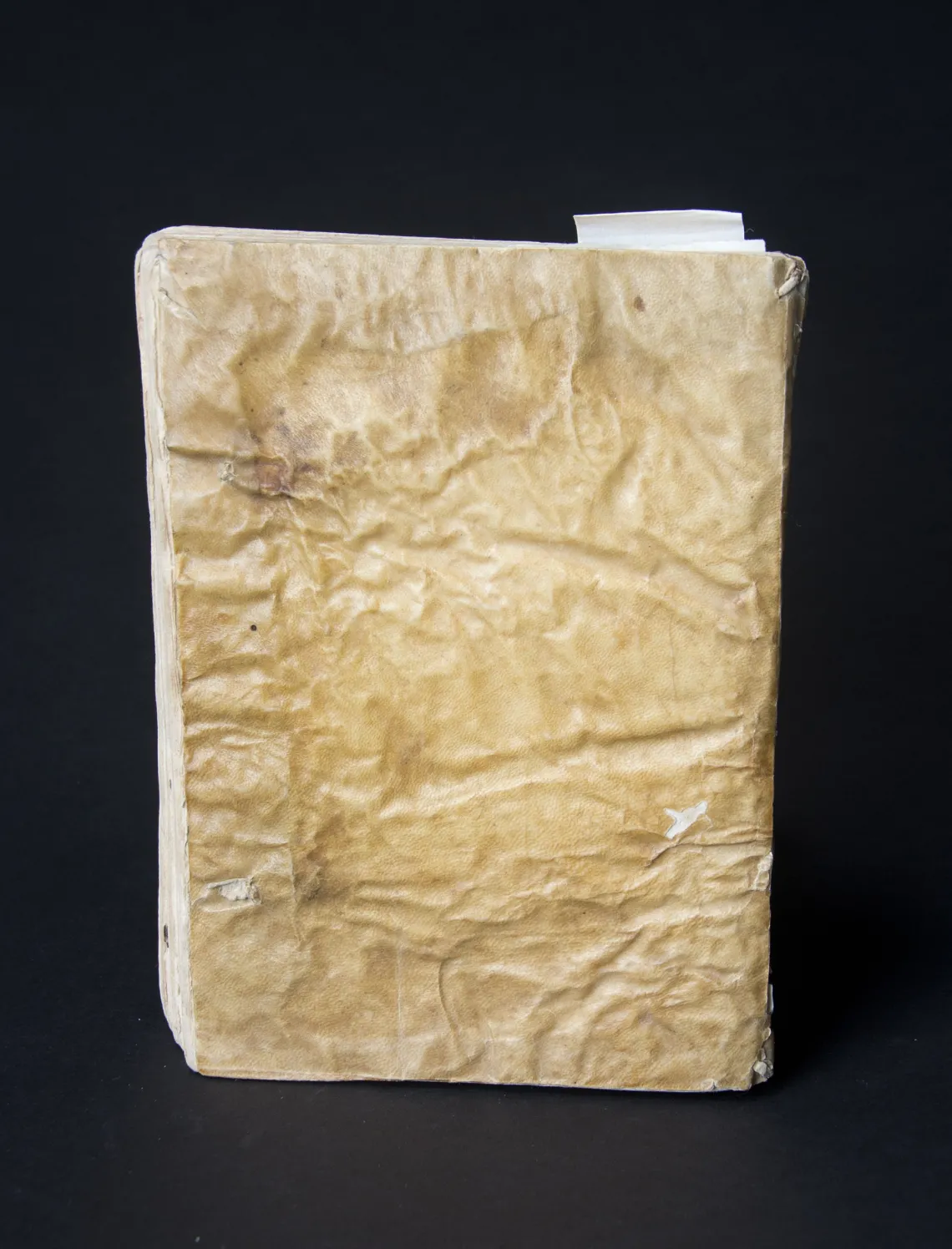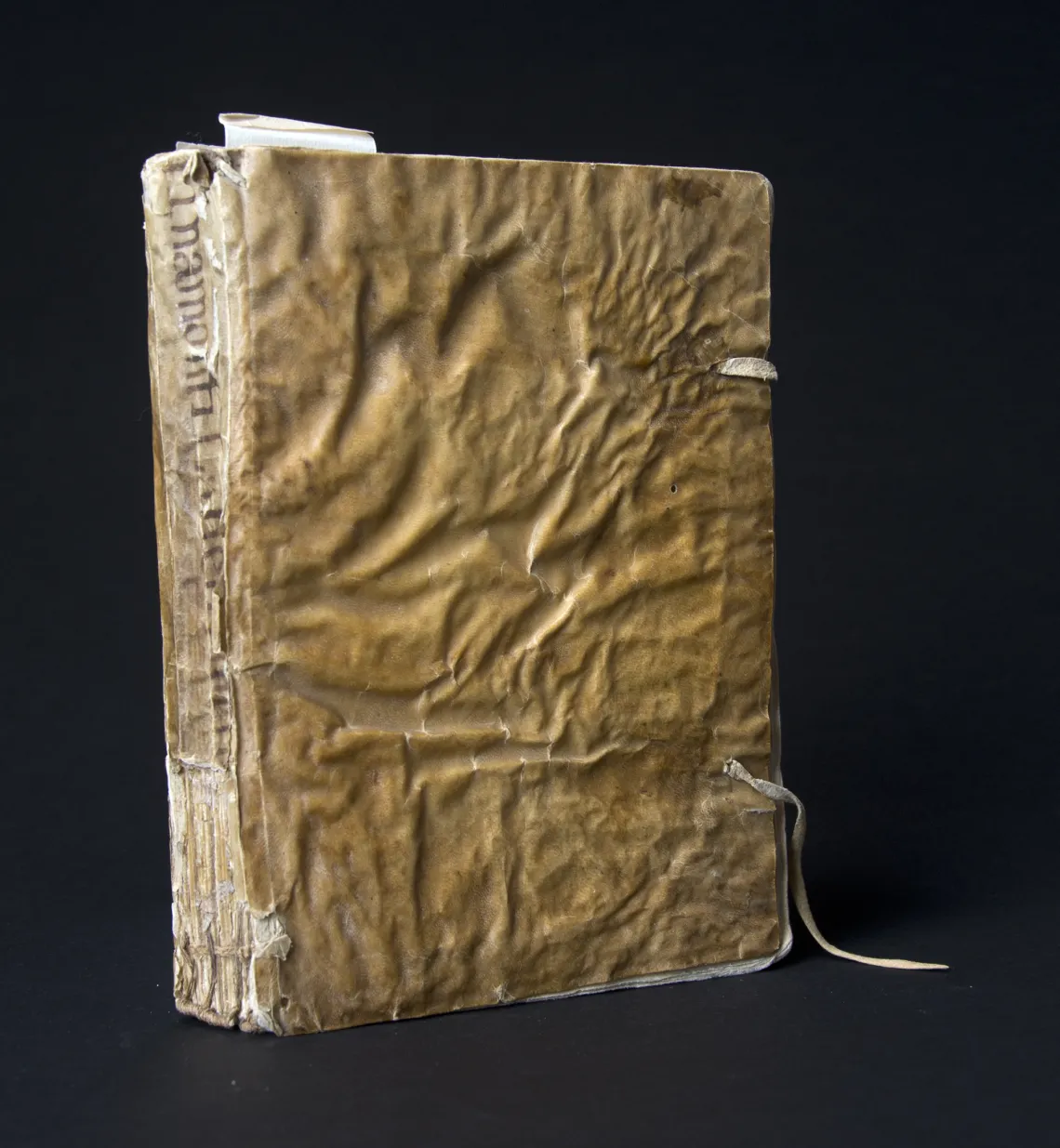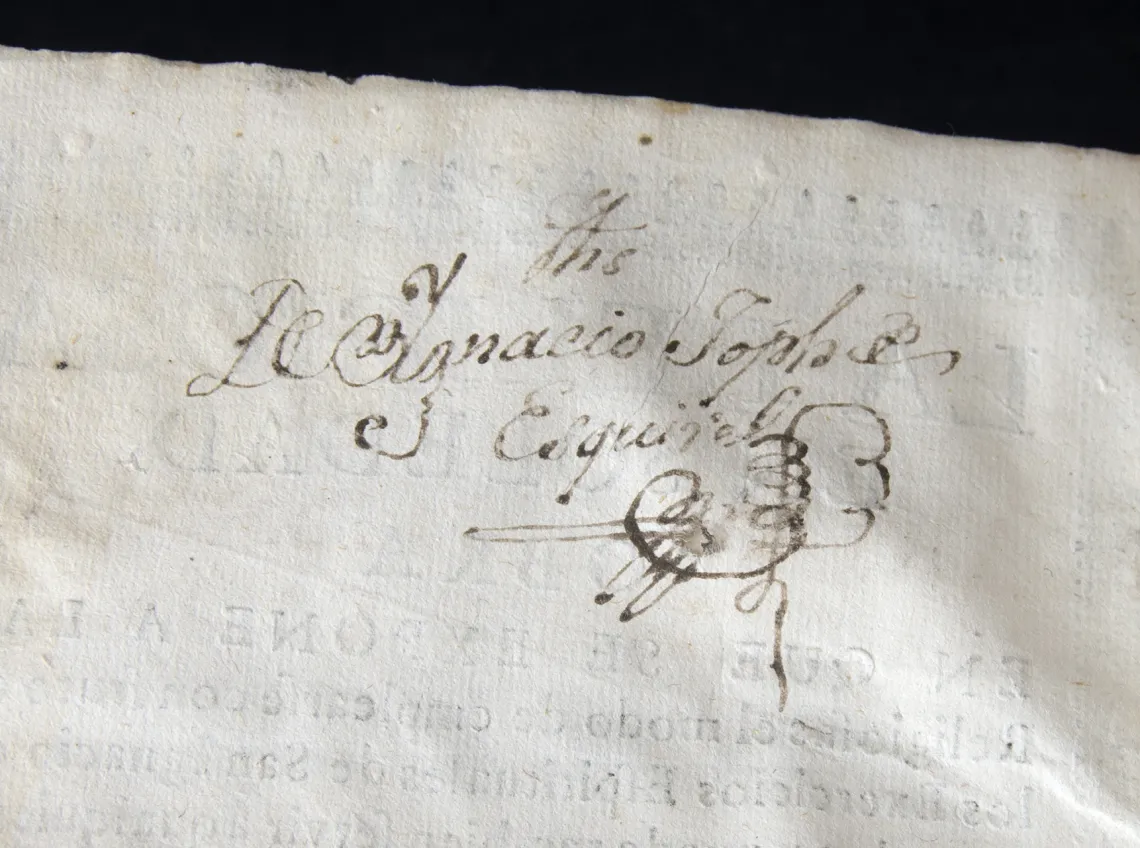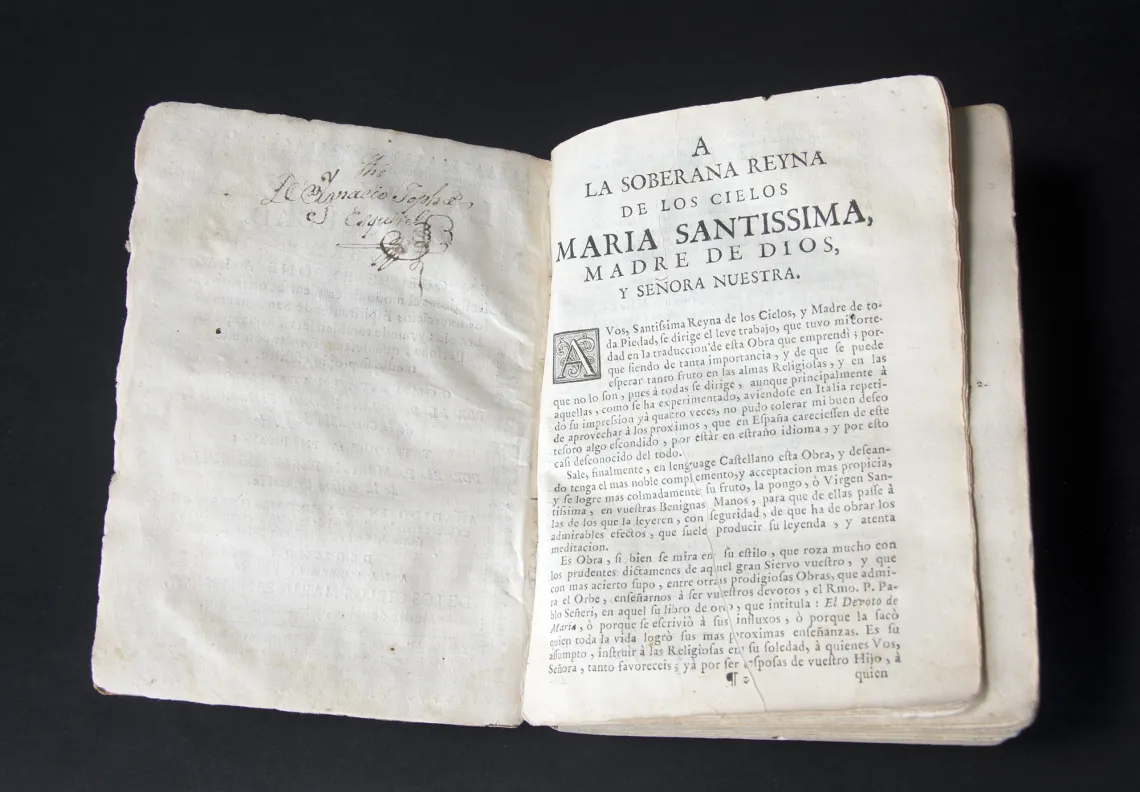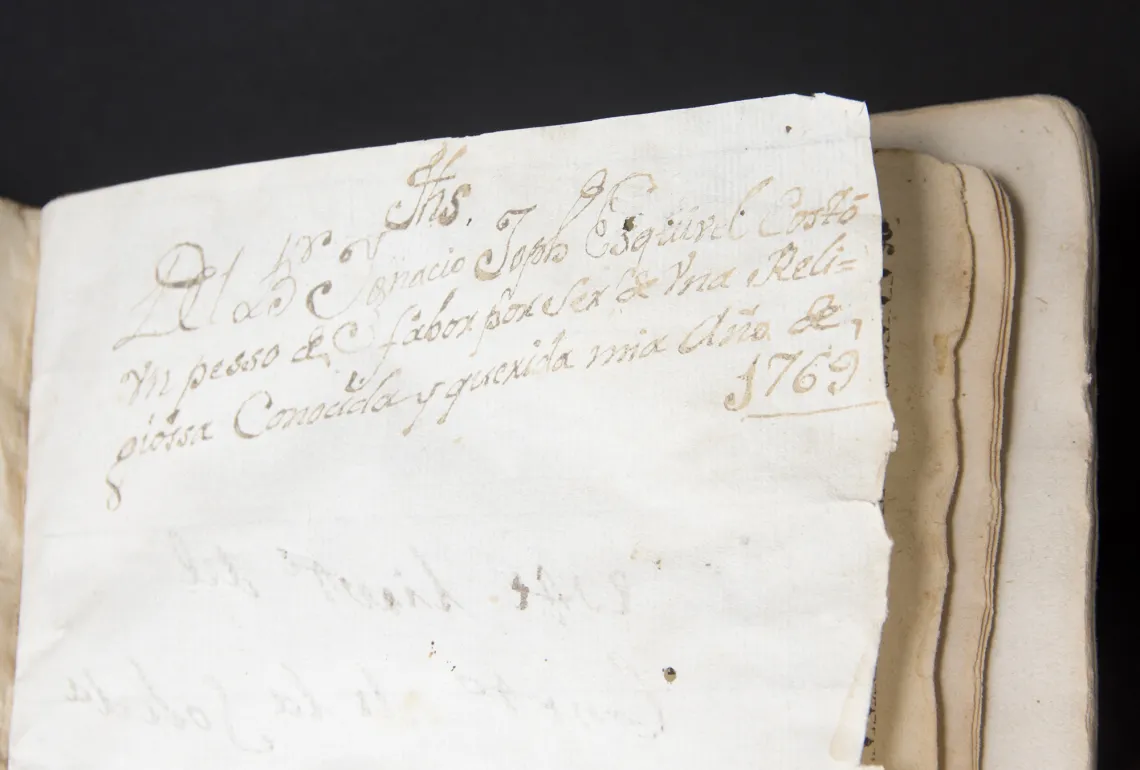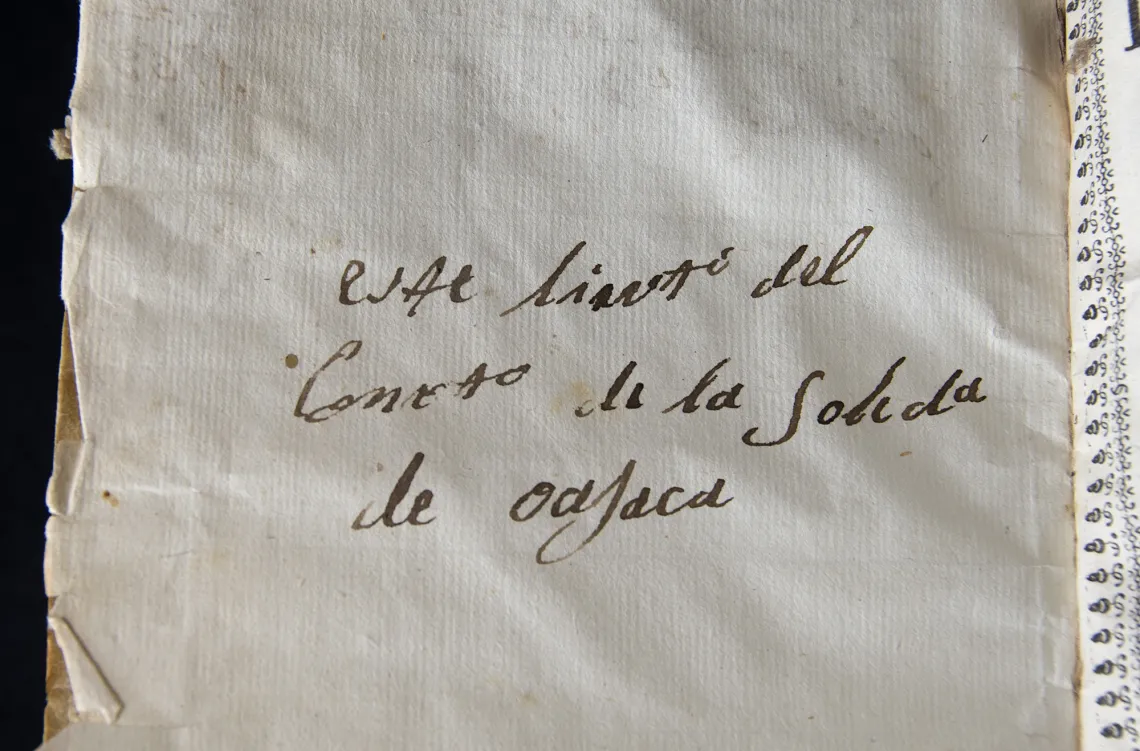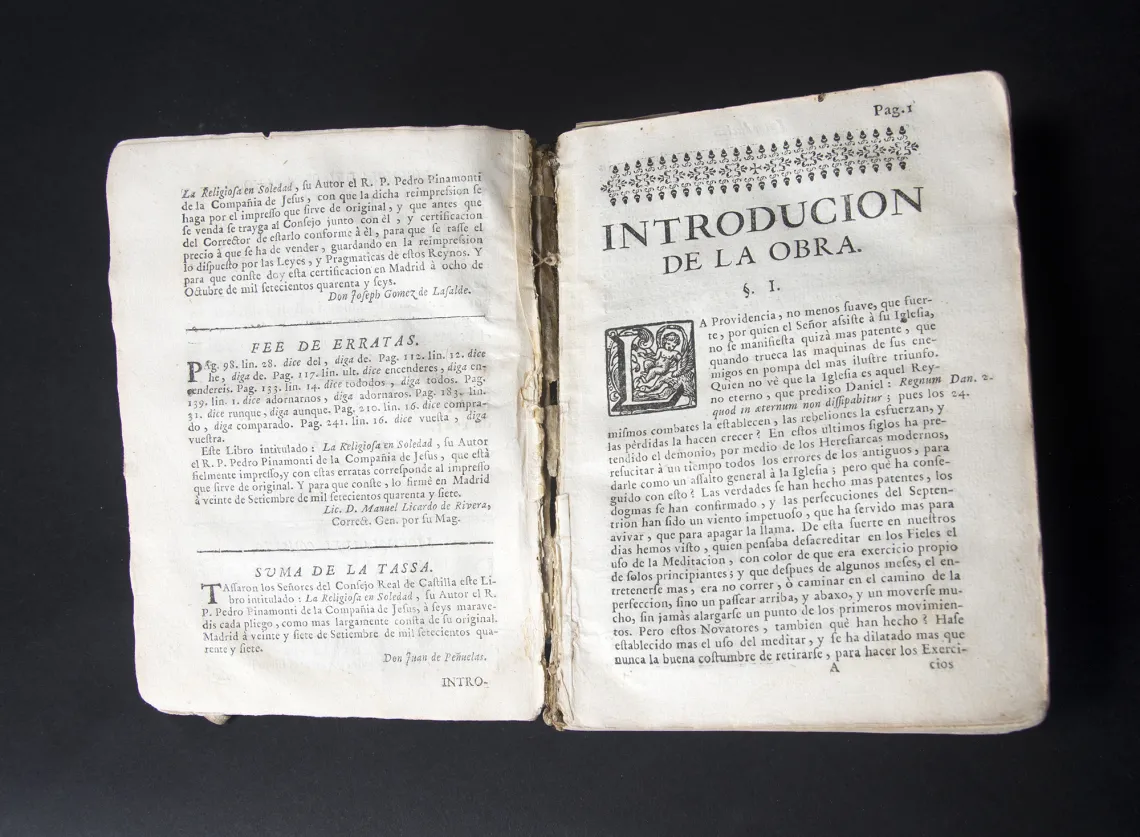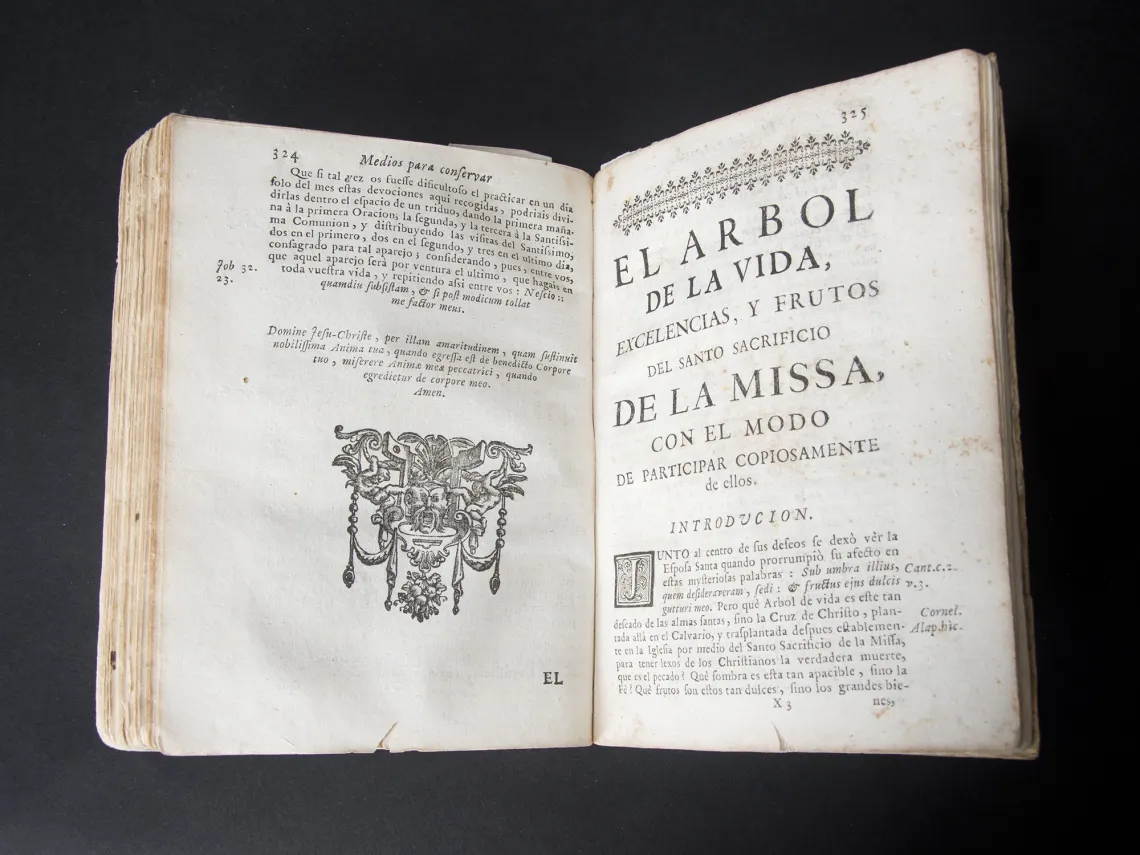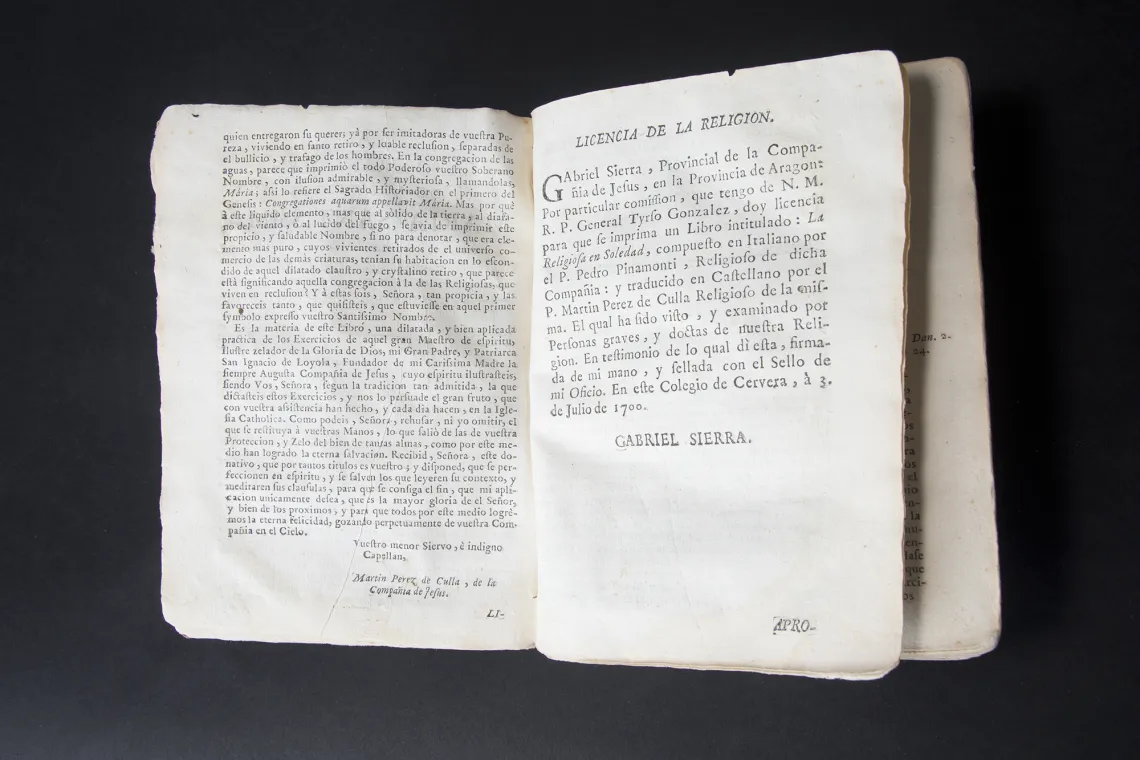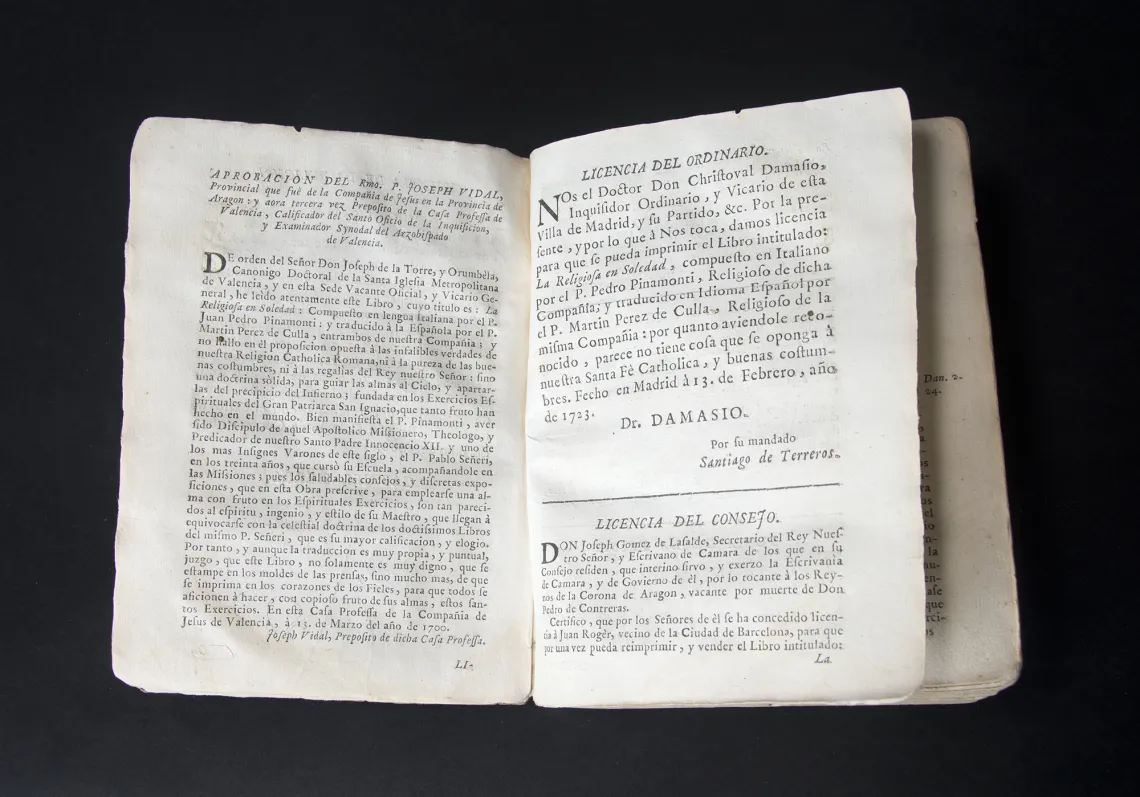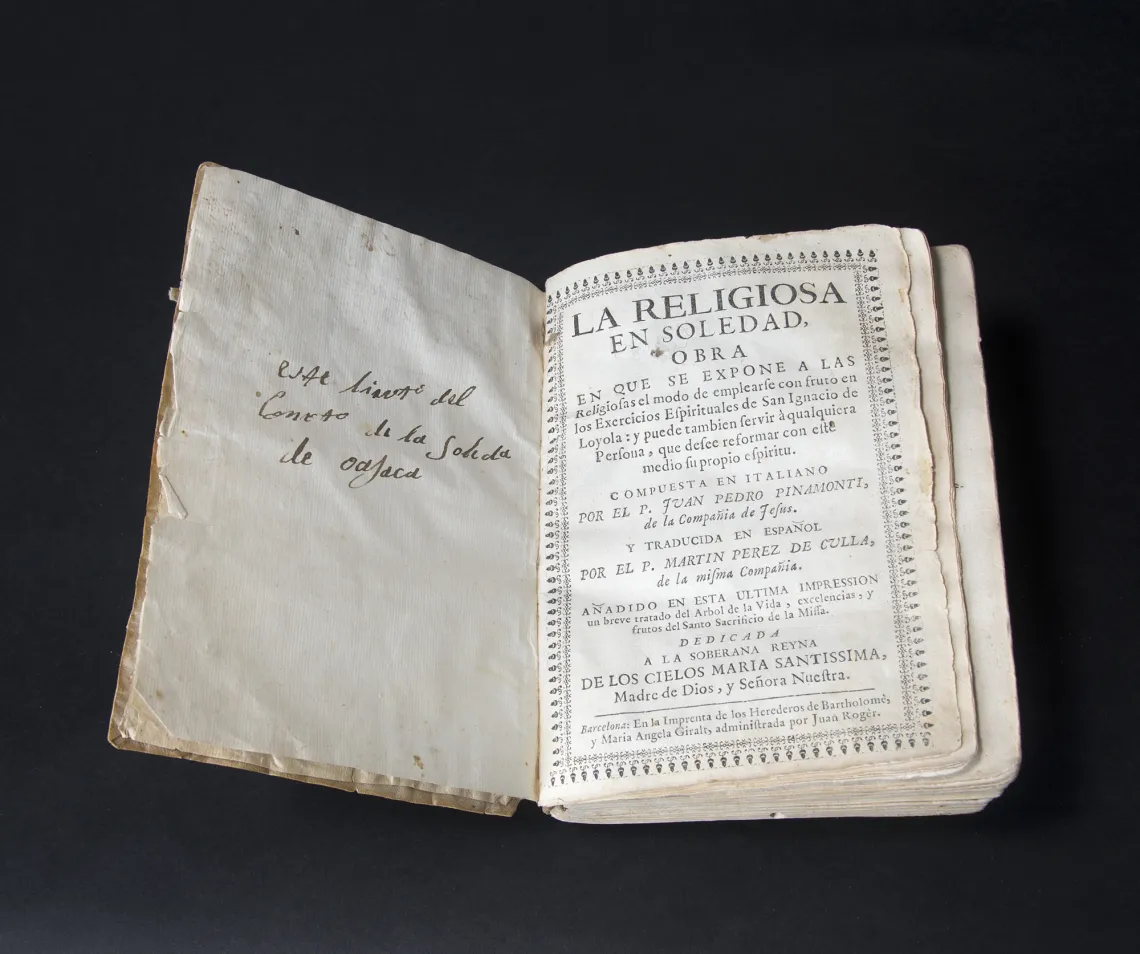
See more images in the slideshow below
La Religiosa
ca. 1700, Barcelona, Spain
By Juan Pedro Pinamonti, S.J.
Translated from the Italian into Spanish by Martín Pérez de Culla, S.J.
Length: 6.0 in. (15.2 cm), Width: 1.8 in. (4.5 cm), Height 7.8 in. (19.7 cm)
Gift of Ann Price to the ASM Library & Archives, 2014
(ASM Library Catalog # BX2179.L8P55 1723)

Text by Dr. Michael M. Brescia, Curator of Ethnohistory and Professor of History, September 2014
Print Culture and European Empires in North America
At first glance, this old book, published in Spain and bound in vellum centuries ago, brings to mind the venerable libraries of Europe, where ecclesiastical and royal authorities preserved knowledge of the sacred and profane. While the book may seem antiquated to some in light of the digital revolution, it reminds us that Spain nurtured and sustained its colonial enterprise in North America through print culture.
I selected La religiosa (literally, “the female religious,” a collective phrase meaning nuns) because it illustrates the influence of the Society of Jesus, a Roman Catholic order of religious men, on the spirituality of nuns throughout the Spanish empire. At one time the book graced the shelves of the Convent of Our Lady of Solitude in Oaxaca, Mexico, where a priest bought it, from a nun, for one peso in 1769.
Daily prayer and frequent reception of the sacraments fostered the virtues of humility and obedience within the routine of the contemplative life. Living secluded in convents, as the "brides of Christ," nuns were sheltered from the harsher realities of the world. Catholic society in Spain and its colony, New Spain (Mexico), however, found solace in the nuns’ prayers and devotions as the path toward salvation.
That the institutional church—dominated by an all-male hierarchy—made every effort to direct the spirituality of nuns reflects the patriarchal dimensions of Spanish colonialism and its preoccupation with linking the broader social order to a disciplined piety.
The Joys and Advantages of Print Culture
As a historian who has spent plenty of time in rare-book libraries and archives perusing dusty old books and manuscripts, I never tire in sharing my enthusiasm for print culture. As a scholar who wears multiple hats at ASM—administrator, museum curator, and history professor—I find it particularly challenging that many of my students prefer to view electronic images of manuscripts and rare books in the comfort of their homes sitting in front of their computers. I struggle to get them to visit the venerable ASM Library and Archives or the University of Arizona Special Collections where they can see, touch, and smell a book or document that was produced ages ago.
Please don’t get me wrong, I am no Luddite. I am not averse to technology and the advances that have been made in conservation of and scholarly access to hard-to-come-by books and manuscripts. But there is something to be said for visiting a library, putting on a pair of white gloves and even a mask, and turning the pages of an old manuscript that reveals dimensions of a specific time and locale.
An Outstanding Rare Book Library
The library in Mexico where I spend most of my time is the Biblioteca Palafoxiana, founded in 1646 in the city of Puebla by Bishop Juan de Palafox y Mendoza. He donated his personal library of 5000 volumes as a way to activate the educational reforms of the Council of Trent. It remains the only rare book library in Mexico that maintains its original inventory, which is one of many reasons why I travel to Puebla instead of Mexico City. Many libraries in Mexico have lost portions of their cultural patrimony since independence from Spain in 1821 and the reasons are varied: foreign invasions, civil war, political discord, the Mexican Revolution, political capriciousness, theft, etc.
The Palafoxiana Library contains first, second, and even revised editions of books not found in other rare book repositories. So when a historian of Mexican law, for example, needs to examine a legal treatise written in the early nineteenth century with subsequent commentary and notes added to a later edition, the Biblioteca Nacional in Mexico City may not have what the scholar needs. Moreover, this National Library in Mexico City (or our own libraries in the United States) may have copies or facsimiles of these old books but not the originals. And there is nothing like putting on gloves and sitting down to read and turn the pages of the original.
Books Speak to Us—and to Each Other
Some of my fondest memories of conducting historical research have taken place in the Biblioteca Palafoxiana, and when I am there I cannot help but think of Umberto Eco’s popular novel that appeared in the early 1980s, The Name of the Rose. Years before Dan Brown’s The Da Vinci Code topped the best seller lists in North America Umberto Eco captivated the imagination of his readers by conjuring vivid images of daily life in a medieval monastery. Eco described the many books and illustrated manuscripts that graced the library shelves of a Benedictine monastery in northern Italy—books and manuscripts that conversed with each other, sharing their contents and knowledge with one another.
In my case, the books in the Biblioteca Palafoxiana do indeed seem to speak to each other, for time spent reading one book inevitably generates clues to another. My current research examines the living legacies of the Spanish and Mexican civil law of property in the United States. This project remains unfinished precisely because one rare book provides the name of another that, upon closer examination, speaks of yet another book of which I was unaware. Thus, we have a domino effect of books referencing other books.
Hover your mouse over the image to stop the slideshow
La Religiosa
ca. 1700, Barcelona, Spain
By Juan Pedro Pinamonti, S.J.
Translated from the Italian into Spanish by Martín Pérez de Culla, S.J.
Length: 6.0 in. (15.2 cm), Width: 1.8 in. (4.5 cm), Height 7.8 in. (19.7 cm)
Gift of Ann Price to the ASM Library & Archives, 2014
(ASM Library Catalog # BX2179.L8P55 1723)
Link
Print Culture 101: A Cheat Sheet and Syllabus from The Atlantic
References
Bancroft Library
- 1962 Mexico Ancient and Modern as Represented by a Selection of Works in the Bancroft Library: An Exhibition Celebrating the Acquisition of the Silvestre Terrazas Collection. The Friends of the Bancroft Library and the University of California, Berkeley.
Brescia, Michael M.
- 1999 Material and Cultural Expressions of Episcopal Authority: Tridentine Donation and the Biblioteca Palafoxiana in Seventeenth-Century Puebla de los Angeles, Mexico. Colonial Latin American Historical Review 8:207-227.
Calvo, Hortensia
- 2003 The Politics of Print: The Historiography of the Book in Early Spanish America. Book History 6:277-305.
Delgado-Gómez, Angel
- 1994 Spanish Historical Writing about the New World, 1493-1700. The John Carter Brown Library, Providence.
Eco, Umberto
- 1984 The Name of the Rose. Translated from the Italian by William Weaver. Warner Books, Inc., New York.
Garibay Álvarez, Jorge, and José Joel Peña Espinosa (editors)
- 2004 Inventario general de manuscritos de la Biblioteca Palafoxiana. Fundación Mapfre Tavera and Secretaría de Gobierno del Estado de Puebla, Madrid and Puebla, Mexico
Penney, Clara Louisa (compiler)
- 1965 Printed Books 1468-1700 in The Hispanic Society of America. The Hispanic Society of America, New York.
Raat, W. Dirk, and Michael M. Brescia
- 2010 Mexico and the United States: Ambivalent Vistas. Fourth Edition. University of Georgia Press, Athens.






